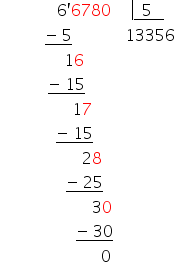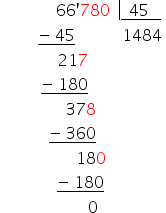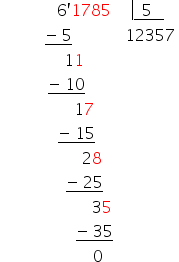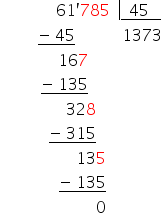Use the following questions to test your knowledge with split accounts and clear your doubts with the commented resolution.
Question 1
Make the following divisions and classify them as exact or not exact.
a)
- 150÷3
- 37÷15
- 224÷8
- 108÷32
Answer:
Replies:
a) It is an exact division, because there is no rest.

b) It is an inaccurate division, as there are 7 more.

c) It is an exact division, because there is no rest.

d) It is an inaccurate division, since there are 12 left.

Question 2
Júlia decided to sell boxes of sweets to raise money and be able to travel on vacation. She bought 12 boxes and produced the ingredients: 50 brigadeiros, 30 kisses, 30 cashews and 40 happily married. According to Júlia’s production, how many sweets should she put in each box to be sold?
Answer:
Correct answer: 12 candies.
The first thing to do is add up how many sweets were produced.
50 + 30 + 30 + 40 = 150 sweets
Now, we can make a division account and the quotient will give the number of boxes that Julia should use.

Therefore, each box must contain 12 candies and 6 candies will remain.
Question 3
To conduct a volleyball championship at a school, the physical education teacher decided to divide the 96 students into groups. Knowing that each team for this sport must consist of 6 people, how many teams did the teacher manage to form?
Answer:
Correct answer: 16 teams.
To find the number of teams, simply divide the total number of students by the number of people that must contain in each team.

Therefore, there is no rest in the division and all students will be placed in the 16 teams formed.
Question 4
Based on operation 14 2 = 7, check whether the statements below are correct or wrong.
a) Number 2 is the divisor of the operation.
b) The quotient is the result of the operation.
c) This operation is inverse to multiplication.
d) Equality equivalent to the operation is 7 x 2 = 14.
Answer:
Answer: all alternatives are correct.
This operation can be represented as follows:

Analyzing the alternatives, we have:
a) CORRECT. The number 2 divides the number 14 and the operation presents the result 7.
b) CORRECT. The transaction quotient is number 7, which corresponds to the result.
c) CORRECT. This represents that 7 is contained twice in the number 14.
d) CORRECT. If multiplication is the inverse operation of division, then 14 ÷2=7e
2×7=14
Question 5
For a birthday, the 30 tables available in the ballroom were distributed so that each table would be for 6 guests and, even so, there would still be 2 guests to accommodate. Knowing this, calculate how many people were invited to the party.View Answer
Correct answer: 182 guests.
To answer this question, you must determine who each term in that operation is:
quotient x divisor + remainder = dividend
The dividend, which is the result, corresponds to the number of guests.
Let’s interpret the question.
- If 2 guests have not stayed at any of the 30 tables, then the number 2 represents the rest.
- The number of guests is divided by table, so this is the dividend.
- The number of tables is the divisor, as it will distribute the number of guests.
- The number of people per table is the quotient, as it corresponds to the result of the division.
Substituting the numbers in the operation, we have:
Quotient x divisor + remainder = dividend
6 x 30 + 2 = x
180 + 2 = x
182 = x
To prove it, we can use the split operation.

Therefore, the number of party guests is 182.
Question 6
In a cinema the rows were distributed according to the letters of the alphabet, from the letter A to the letter I. Knowing that the cinema room has 126 seats, how many seats were placed in each row?View Answer
Correct answer: 14.
The first step in resolving this issue is to find the number that corresponds to the letter I.
A, B, C, D, E, F, G, H, I
1, 2, 3, 4, 5, 6, 7, 8, 9
Therefore, in the cinema there are 9 rows numbered from letter A to letter I.
Now, we must divide the number of seats by the number of rows.

Therefore, we have an exact division in which the number of seats per row is 14.
Question 7
At the end of a football championship, the winning team had 19 points. To achieve this score, the team had only one draw and was victorious in the other games. Determine how many games they have won, knowing that a tie gives 1 point and a win gives 3 points.View Answer
Correct answer: 6 wins.
If the team had only one draw and that result gave only 1 point to the team, then to find the number of victories it is necessary to first subtract that point in the final score and find the points that correspond to the victories.
19 – 1 = 18
Now, to find out the number of victories just divide the 18 points by the 3 points that are worth each team triumph.

Therefore, the winning team had 6 victories.
Question 8
A public market was built over an area of 6,000 square meters. In preparing the land, the space was divided into three equal parts. Two parts were used to build 50 boxes for the marketers and the remaining part was reserved for parking. Calculate the box area built.View Answer
Correct answer: 80 square meters.
1st step: find the area of each of the three parts where the land was divided.

2nd step: add the area of the two parts used.
2,000 m 2 + 2000 m 2 = 4 000 m 2
3rd step: divide the area reserved for marketers by the number of boxes built.

Therefore, each box has an area of 80 m 2 .
Question 9
Find the result of dividing the number 632 by the number 158 using only the subtraction operation.
Answer:
Correct answer: 4.
To resolve this issue, we must perform successive subtractions until the result is 0.

To find the result of the division we just have to count the number of times that the number 158 was repeated.
Since the number 158 was repeated four times, then 4 is the result of dividing 632 by 158.
158 x 4 = 632
Note that by performing the multiplication operation, the result will be the dividend, since multiplication is the inverse operation of the division.
To prove the result, see the result of dividing 632 by 158.

Question 10
(OBMEP) In number 6a78b, the number a is in the order of units of thousands and the number b is in the order of units. If 6a78b is divisible by 45, then the value of a + B is:
a) 5
b) 6
c) 7
d) 8
e) 9View Answer
Correct alternative: b) 6.
Regarding the divisibility of the number 6a78b by 45, we can make the following interpretation:
- If the number is divisible by 45, then it can also be divided by 9 and 5, since 9 x 5 = 45.
- Every number that is divisible by 5 has the unit number equal to 0 or 5.
- Every number that is divisible by 9 has as a result of the sum of its numbers a multiple of 9.
For the number 6a78b with b equal to 0 or 5, we have:

For the number 6a78b to be a multiple of 9, we have:

27 is a multiple of 9, because 9 x 9 x 9 = 27.
Therefore, a + b is equal to 6, because

We can prove that the numbers are really divisible by 5, 9 and 45.
For the number 66780, we have:



For the number 61785, we have:


Division by 9


